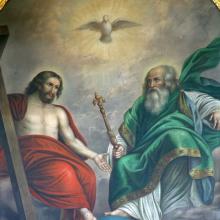holy trinity

piosi / Shutterstock.com
SUMMER IS ALMOST HERE, and churches ... slow ... down. Folks are planning for vacation. Staff are away. Pastors are away. It’s as if we take our status as middle-class bourgeoisie more seriously than our baptismal vows.
By contrast, in the summer the biblical texts pick up—in intensity, directness, drive. Pentecost falls on us like an avalanche of fire, teaching us languages we don’t know, names, places, people. The old joke is that war is God’s way of teaching geography to Americans. No, in the church, that would be Pentecost. The descent of the Holy Spirit empowers people to preach who most say shouldn’t (in our texts that includes Arabic-speakers, women, unnamed prophets), and confounds those of us who think we “should.” Then Trinity Sunday, and all three persons of the triune Godhead are on the stage. We now know God as fully as God can be known by mere creatures. What we can’t know is not because God is tragically removed or far away. No—it’s precisely because God has come so unbearably close and is so unimaginably beautiful. That’s why we can’t take all of God in. So we praise instead of merely examine. And then Jesus sends out the disciples in mission to do what he does, or even greater things. Teach. Heal. Exorcise. Baptize. This doesn’t sound like a summer vacation or even a mission trip. It sounds like a new way of being in community for others.
That’s what the church is, in summer or anytime.
ONE OF THE most well-known and revered icons today is Andrei Rublev’s reflection on the Holy Trinity, painted between 1422 and 1425 in Russia. It depicts three angels seated around a table that bears a chalice. The female figures form a circle evoking deep mutuality, interconnectedness, and love between one another. But the circle is open, inviting the world into this profound experience of community. As Christine Challiot, an Eastern Orthodox laywoman, wrote, “Rublev painted the three angels with a circular motion to signify their unity and equality, ‘thus creating a unity to represent the Holy Trinity in its movement of love.’”
This profound reflection is set in the biblical context of giving hospitality to the stranger. The icon depicts the story of the hospitality offered by Abraham and Sarah in Genesis 18:1-15 to three strangers. Abraham rushed to offer them hospitality—water and food.
The three migrating strangers are messengers of God. The text says simply that they were the Lord; interpreters see the three as the presence of the Trinity. And they, in turn, bring an announcement that Sarah, in her old age, will bear a son, fulfilling God’s promises. Sarah and Abraham suddenly find the tables reversed, and they are the guests at God’s table, being invited into this community of love. Thus, Catholic theologian Elizabeth Johnson explains, “This is a depiction of a trinitarian God capable of immense hospitality who calls the world to join the feast.”
This biblical story is a declaration of the unexpected, life-giving presence of God, discovered through providing hospitality to strangers. Rabbi Jonathan Sacks notes that the love of strangers is declared 36 times in the Hebrew scriptures, as opposed to the love of neighbor, mentioned only once. The love of strangers and sojourners is a primary test of one’s love for God; this is linked to the presence of migrating people, with whom we can unexpectedly encounter God in fresh and promising ways that open the future to new possibilities.
You may not realize this, but senior pastors throughout the world were on vacation last Sunday. Not because they were celebrating the American holiday weekend of Memorial Day. No, senior pastors the world over were conveniently on vacation because it was Trinity Sunday.
Of course, I can’t blame pastors for taking a nice weekend vacation and leaving the challenge of preaching the Trinity Sunday sermon to their associates. I’ve always had a hard time with the Trinity — not because of the math. I was always horrible at math. I frequently tell people I became a pastor and a blogger because I failed Algebra. So, the concept that 1 + 1 + 1 = 1 has never been an issue for me.
Holy Trinity is not the most popular festival among preachers who, for all the other seasons and special days of the church year, normally get to dig into interesting gospel narratives.
Most other festivals of the church celebrate an event. We commemorate happenings in the life of Christ: Mary’s visit from Gabriel announcing the miraculous child she was to bear into the world, God’s own word made flesh. We celebrate also the light bearing nature of your own patronal season of Epiphany, we celebrate the messy Baptism of our Lord, the confusing Transfiguration, and Jesus riding triumphant into Jerusalem amidst palms and cheers. We celebrate the empty tomb of Easter, the glorious Ascension, the chaotic coming of God’s spirit to the church at Pentecost all leading up to today, when we celebrate … a church doctrine.
Preachers dread this day because we see it as kind of a dry dusty theological topic after such the exciting and earthy part of the liturgical year that came before it. It’s like there’s this raucous party of Easter and Pentecost that comes to a screeching halt while an old crotchety man shuffles up to the pulpit, blows the dust off an enormous leather-bound book, clears his throat saying And now a celebration of church doctrine causing the music to fade, the last of the Pentecost streamers still floating to the ground. Church doctrine Sunday.

